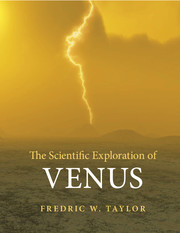Book contents
- Frontmatter
- Contents
- Overview
- Prologue
- A note on scientific units
- Acknowledgements
- Part I Views of Venus, from the beginning to the present day
- Part II The motivation to continue the quest
- Part III Plans and visions for the future
- Chapter 16 Solar system exploration
- Chapter 17 Coming soon to a planet near you
- Chapter 18 Towards the horizon
- Chapter 19 Beyond the Horizon
- Epilogue
- References and acknowledgements
- Appendix A Chronology of space missions to Venus
- Appendix B Data about Venus
- Index
- Plate section
Chapter 16 - Solar system exploration
what next for Venus?
from Part III - Plans and visions for the future
Published online by Cambridge University Press: 05 September 2014
- Frontmatter
- Contents
- Overview
- Prologue
- A note on scientific units
- Acknowledgements
- Part I Views of Venus, from the beginning to the present day
- Part II The motivation to continue the quest
- Part III Plans and visions for the future
- Chapter 16 Solar system exploration
- Chapter 17 Coming soon to a planet near you
- Chapter 18 Towards the horizon
- Chapter 19 Beyond the Horizon
- Epilogue
- References and acknowledgements
- Appendix A Chronology of space missions to Venus
- Appendix B Data about Venus
- Index
- Plate section
Summary
Choosing the way forward
When Venus Express arrived in April 2006 it became the 25th mission to target Venus successfully. With Japan’s Akatsuki, four spacefaring nations are now engaged in exploring Venus, and the data garnered have painted a vivid and comprehensive picture of what hitherto had been a mysterious, cloud-shrouded world. No seas, swamps or rainforests and no dinosaurs or Treens, but a hot volcanic wasteland with permanent hurricanes and searing acid clouds.
There were, and still are, plenty of puzzles to solve concerning the nature of the surface and interior, and the behaviour of the thick atmosphere. More missions must follow. But what, how and when? The scientists, engineers, managers and politicians who will answer these questions and write the next chapter in Venus exploration cannot consider Venus as a solitary objective. The agencies face huge internal and external competition for resources, and must target the highest priorities if they are to satisfy their own scientific communities, not to mention their government paymasters. Often this means leaving lower priority destinations unprobed for long periods, as has already happened with Venus during the years from 1994, when Magellan shut down, to 2006, when Venus Express commenced operations. So what happens next at Venus depends not only on goals and priorities for that planet, but on where the excitement lies elsewhere in the Solar System and beyond, and where Venus fits in with the rest of the international planetary programme.
- Type
- Chapter
- Information
- The Scientific Exploration of Venus , pp. 237 - 248Publisher: Cambridge University PressPrint publication year: 2014



